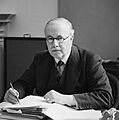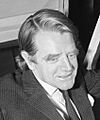Postmaster General of the United Kingdom facts for kids
Quick facts for kids Postmaster General of the United Kingdom |
|
|---|---|

Royal Arms as used by Her Majesty's Government
General Post Office |
|
| Style | Postmaster General |
| Appointer | Monarch of the United Kingdom on advice of the Prime Minister |
| Precursor | Master of the King's Post |
| Formation | 1517 |
| First holder | Brian Tuke as Master of the King’s Post |
| Final holder | John Stonehouse |
| Abolished | 1 October 1969 |
| Succession | Overseen by the following: Department of Trade and Industry (1974–2007) Department for Business, Energy and Industrial Strategy (2007–2015) Home Office (1974–92) Department for Culture, Media and Sport (1992– ) |
The Postmaster General was an important government job in the United Kingdom. This person was in charge of the country's postal system. They made sure letters and packages were delivered. Over time, their role grew to include managing telegraphs, telecommunications, and even broadcasting.
This job was part of the Cabinet, which is a group of top ministers who advise the Prime Minister. The Postmaster General was a minister for HM Government.
The role of Postmaster General ended in 1969. A new public company, called the Post Office, took over. This company was run by a chairman, not a government minister. After 1969, a new, less powerful job called Minister of Posts and Telecommunications was created. This job lasted until 1974. Today, many of the old Postmaster General's duties are handled by the Secretary of State for Culture, Media and Sport.
Contents
History of the Postmaster General
Early Postal System
The story of the Postmaster General began a long time ago in England. As far back as the 1400s, kings used special messengers called couriers to deliver their letters. These couriers would ride horses and pass messages from one to another, like a relay race.
The first official mention of a "Master of the Posts" was in 1512. A man named Brian Tuke was paid for this job. In 1517, King Henry VIII officially appointed him as the "Governor of the King's Posts." This was the very first step towards the Postmaster General job.
Controlling the Mail
In 1609, a rule was made that only people approved by the Postmaster General could carry and deliver letters. This gave the Postmaster General a lot of power over the mail system.
During the time of the Commonwealth (when England was not ruled by a king), John Thurloe became Postmaster-General in 1655. He was known for using his position to intercept mail, meaning he could read people's letters. This helped him uncover plots against the government.
In 1657, a law was passed to set up a postal system for England, Scotland, and Ireland. This law also officially created the Postmaster General position. It made sure that only the postal service could deliver letters and provide horses for mail delivery. After the king returned to power in 1660, a new law confirmed this system and the Postmaster General's role.
The General Post Office
In 1660, the General Letter Office was set up in London. This office later became known as the General Post Office (GPO). It was the main center for the country's mail. Over time, the Postmaster General's responsibilities grew. They started to manage electric telegraphs in 1868 and later took on telecommunications and broadcasting.
End of the Role
The job of Postmaster General was finally ended in 1969 by the Post Office Act 1969. A new public company, the Post Office, was created to handle mail, telecommunications, and banking services (Girobank).
After 1969, a new minister, the Minister of Posts and Telecommunications, took over some duties. However, this department was closed in 1974. Today, many of the old Postmaster General's duties are handled by the Secretary of State for Culture, Media and Sport. The Royal Mail Group is now a private company.
Images for kids
-
Austen Chamberlain (1902-1903)
-
Herbert Samuel, 1st Viscount Samuel (1910-1914 and 1915-1916)
-
Charles Hobhouse (1914-1915)
-
Neville Chamberlain (1922-1923)
-
Sir William Mitchell-Thomson (1924-1929)
-
Clement Attlee (1931)
-
William Ormsby-Gore (1931)
-
Sir Kingsley Wood (1931-1935)
-
George Tryon, 1st Baron Tryon (1935-1940)
-
William Morrison (1940-1943)
-
Harry Crookshank (1943-1945)
-
Wilfred Paling (1947-1950)
-
The Earl De La Warr (1951-1955)
-
Christopher Chataway (1970-1972)
-
Tony Benn (1964-1966)
See also
- Postmaster General (disambiguation)
- Postmasters General of Ireland
- Postmaster General for Scotland
- Postmaster and Deputy Postmaster for Canada 1763–1851 – who reported to the Postmaster General of the United Kingdom
- Postmaster General of Canada
- Postmaster General of Hong Kong – created in 1870 to replace the Royal Mail and under British administration until 1 July 1997



























